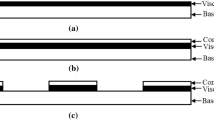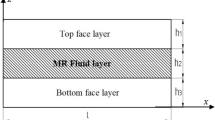Abstract
Background
Despite the increased awareness of vibration control, vibration still causes many problems, such as performance degradation of the equipment and stability violation of flexible structures. In general, the vibration in machines can be caused due to the misalignment, malfunction of mounting parts, changes in temperature, and unbalanced rotating parts. Moreover, the fluctuation in magnetic force due alternating current in transformers and magnetically actuated device can cause unwanted vibrations.
Purpose
The development of sandwich-like structural system with combination of control capabilities plays a very important role to control the unwanted vibrations and to avoid resonance phenomenon due to external disturbances in the system. This problem can be resolved by applying a new sandwich structure incorporating smart fluids such as magnetorheological fluid.
Methods
Here in this research work, design and fabrication of a sandwich beam consisting of three layers are undertaken; two outer layers of aluminium and one core layer of MR fluid. The fabricated sandwich beam is tested to effectively achieve vibration control under various magnetic field conditions.
Results
The research work results show that as the magnetic field intensity increases, the natural frequency of the beam increases, while the peak amplitude, loss factor, and quality factor are decreased.
Conclusion
The principal criterion on the vibration control undertaken in this research work is the increment of the natural frequency as the field intensity increases. Therefore, the resonance behaviour of flexible structure, which can be occurred by external disturbances possessing several frequency spectrum, can be avoided by applying an appropriate magnetic field intensity. This directly means that the natural frequency of the smart sandwich beam can be adaptively controlled by using MR fluid which provides high damping and stiffening effect by means of the semi-active control which does not require any external input power.










Similar content being viewed by others
References
Lord R (1877) Theory of Sound (two volumes). Dover Publications, New York (reissued 1945, second edition)
Bert CW (1973) Material damping: an introductory review of mathematical models, measure and experimental techniques. J Sound Vib 29(2):129–153
Earls SWE (1966) Theoretical estimation of frictional energy dissipation in a simple lap joint. J Mech Eng Sci 8(2):207–264
Beards CF, Williams JL (1977) The damping of structural vibration by rotational slip in structural joint. J Sound Vib 53(3):333–340
Bandstra JP (1983) Comparison of equivalent viscous damping in discrete and continuous vibrating system. Trans ASME J Vib Acoust Stress Reliab Design 105:382–392
Golla DF, Hughes PC (1985) Dynamics of viscoelastic structure-a time domain, finite element formulation. J Appl Mech 52:897–906
McTavish DJ, Hughes PC (1992) Finite element modeling of linear viscoelastic structures: the GHM method. In: proceedings of the 33rd AIAA/ASME/ASCE/AHS/ASC structures, structural dynamics and materials conference, paper no. AIAA-92-2380-CP
Lesieutre G, Bianchini E (1995) Time domain modeling of linear viscoelasticity using an elastic displacement fields. ASME J Vib Acoust 117:424–430
Mead DJ, Marcus S (1969) The forced vibration of a three-layer damped sandwich beam with arbitrary boundary conditions. J Sound Vib 10(2):163–175
Douglas BE (1977) The transverse vibratory response of partially constrained elastic-viscoelastic beams, Ph.D. Thesis, Dept. Mechanical Engg.,Univ. of Maryland at College Park
Doyle J (1997) Wave propagation in Structures. Springer, Berlin
Baz A (1998) Spectral finite element modeling of the longitudinal wave propagation in rods treated with active constrained layer damping. In: 4th ESSM and 2nd MIMR conference, pp. 607–619
Wang G, Wereley NM (1999) Spectral finite element method for wave propagation in a sandwich beam having isotropic face plates and a viscoelastic core. In: AIAA structures, structural dynamics, and materials conference
Kim J, Lee U (1999) Spectral element modelling of the beams with active constrained layer damping. In: AIAA structures, structural dynamics, and materials conference, paper No. 1541, St. Louis, MI. Paper No. 1540, St. Louis, MI
Yanik A, Aldemir U, Bakioglu M (2016) Seismic vibration control of three dimensional structures with a simple approach. J Vib Eng Technol 4:3
Routaray B, Nandi A, Neogy S (2008) Vibration control of a beam using an eddy current damper. Adv Vib Eng 7(4):377–387
Beltran-Carbajal F, Silva-Navarro G, Vazquez-Gonzalez B (2016) Multi-frequency harmonic vibration suppression on mass-spring-damper systems using active vibration absorbers. J Vib Eng Technol 4:1
Roy H, Dutta JK, Datta PK (2013) Dynamic behavior of stepped multilayered viscoelastic beams a finite element approach. J Vib Eng Technol 12:1
Huang Z, Zhang Q, Du C, Li Y (2011) Nonlinear vibration of a viscoelastic beam subjected to both axial forces and transverse magnetic field. J Vib Eng Technol 10:2
Carlson JD, Jolly MR (2000) MR fluid, foam and elastomers devices. Mechatronics 10:555–569
Carlson JD, Coulter JP and Duclos TG (1990) Electrorheological fluid composite structures. US Patent 4923057
Weiss KD, Duclos TG, Chrzan MJ et al. (1996) Magnetorheological fluid composite structures. US Patent specification 5547049
Coulter JP (1993) Engineering application of ER materials. J Intell Mater Syst Struct 4(2):248–259
Don DL (1993) An investigation of electrorheological material adoptive structure, Master thesis, Lehigh University, Bethlehem, Pennsylvania
Yalcintzas M, Coulter JP (1995) Analytical modeling of electrorheological material based adaptive beams. J Intell Mater Syst Struct 6(4):488–497
Yalcintas M, Coulter JP (1995) Electrorheological material based adaptive beams subjected to various boundary conditions. J Intel Mater Syst Struct 6(5):700–717
Lee CY (1995) Finite element formulation of a sandwich beam with embedded electro-rheological fluids. J Intel Mater Syst Struct 6(5):718–728
Yeh JY, Chen LW, Wang CC (2004) Vibration of a sandwich plate with a constrained layer and electrorheological fluid core. Compos Struct 65(2):251–258
Yeh JY, Chen LW, Wang CC (2007) Finite element dynamic analysis of orthotropic sandwich plates with an electrorheological fluid core layer. Compos Struct 78(3):368–376
Yeh JY, Chen LW, Wang CC (2006) Dynamic stability analysis of a rectangular orthotropic sandwich plate with an ER fluid core. Compos Struct 72(1):33–41
Yeh JY (2007) Vibration analyses of the annular plate with ER fluid damping treatment. Finite Elem in Anal Design 43(11):965–974
Yeh JY, Chen LW, Lin CT, Liu CY (2009) Damping and vibration analysis of polar orthotropic annular plates with ER treatment. J Sound Vib 325(1):1–13
Hasheminejad SM, Maleki M (2009) Free vibration and forced harmonic response of an electrorheological fluid-filled sandwich plate. Smart Mater Struct 18(5):055013
Mohammadi SR (2012) Nonlinear free vibration analysis of sandwich shell structures with a constrained ER fluid layer. Smart Mater Struct 21(7):075035
Aravindhan TS, Gupta K (2006) Application of magnetorheological fluid dampers to rotor vibration control. Adv Vib Eng 5(4):369–380
Gupta K, Pandey RK, Reddy RK, Banda MN, Dodiya JS, Patil NS (2014) Analysis and design of a magnetorheological (MR) fluid finite squeeze film damper. J Vib Eng Technol 2:4
Xu Z, Gong X, Chen X (2011) Development of a mechanical semi-active vibration absorber. J Vib Eng Technol 10(3)
Yalcintas M, Dai H (1999) Magnetorheological and electrorheological materials in adaptive structures and their performance comparison. Smart Mater Struct 8(5):560–573
Yalcintas M, Dai H (2004) Vibration suppression capabilities of magnetorheological materials based adaptive structures. Smart Mater Struct 13(1):1–11
Sun Q, Zhou J-X, Zhang L (2003) An adaptive beam model and dynamic characteristics of magnetorheological materials. J Sound Vib 261(3):465–481
Yeh Z-F, Shih Y-S (2006) Dynamic characteristics and dynamic instability of magnetorheological material-based adaptive beams. J Compos Mater 40(15):1333–1359
Hu B, Wang D, Xia P, Shi Q (2006) Investigation on the vibration characteristics of a sandwich beam with smart composites- MRF. World J Model Simul 2:201–206
Vasudevan R, Sedaghati R, Rakheja S (2010) Vibration analysis of a multi-layer beam containing magnetorheological fluid. Smart Mater Struct 19(1):015013
Lara-Prieto V, Parkin R, Jackson M, Silberschmidt V, Kesy Z (2010) Vibration characteristics of MR cantilever sandwich beams: experimental study. Smart Mater Struct 19(1):015005
Li YH, Fang B, Li FM, Zhang JZ, Li S (2011) Dynamic analysis of sandwich plates with a constraining layer and a magnetorheological fluid core. Polym Compos 19(4–5):295–302
Yeh J-Y (2013) Vibration analysis of sandwich rectangular plates with magnetorheological elastomers damping treatment. Smart Mater Struct 22(3):035010
Rajamohan V, Rakheja S, Sedaghati R (2010) Vibration analysis of a partially treated multi-layer beam with magnetorheological fluid. J Sound Vib 329(17):3451–3469
Rajamohan V, Sundararaman V, Govindarajan B (2013) Finite element vibration analysis of a magnetorheological fluid sandwich beam. In:proceedings of the international conference on design and manufacturing (IConDM’13), vol. 64, pp. 603–612, July 2013
Rajamohan V, Ramamoorthy M (2012) Dynamic characterization of non-homogeneous magnetorheological fluids based multi-layer beam. Appl Mech Mater 110–116:105–112
Rajamohan V, Natarajan P (2012) Vibration analysis of a rotating magnetorheological fluid sandwich beam. In: proceedings of the international conference on advanced research in mechanical engineering (ICARME’12), pp. 978–93, Tirupati, India, May 2012
Kolekar S, Venkatesh K, Oh J-S, Choi S-B, Controllable sandwich structures with smart materials of electro-rheological fluids and magneto-rheological materials-a review. J Vib Eng (accepted manuscript JVET/CW/1016)
Momeni S, Zabihollah A, Behzad M (2017) Experimental works on dynamic behavior of laminated composite beam incorporated with magneto-rheological fluid under random excitation. In: proceedings of the 3rd international conference on mechatronics and robotics engineering, pp. 156–161, Paris, France, February 2017
Chen L, Hansen CH (2005) Active vibration control of a magnetorheological sandwich beam. In: proceedings of acoustics 2005
Shreedhar Kolekar (2014) Vibration Analysis of Simply Supported Magneto Rheological Fluid Sandwich Beam. Appl Mech Mater. 2014(612):23–28
De Silva CW (2007) Vibration damping, control, and design. CRC Press, Boca Raton
Thomson W (1996) Theory of vibration with applications. CRC Press, Boca Raton
Lazan BJ (1968) Damping of materials and members in structural mechanics. Pergamon, Oxford
Prandina M, Mottershead JE, Bonisoli E (2009) An assessment of damping identification methods. J Sound Vib 323:662–676
Phani AS, Woodhouse J (2007) Viscous damping identification in linear vibration. J Sound Vib 303:475–500
Gaylard ME (2001) Identification of proportional and other sorts of damping matrices using a weighted response integral method. Mech Syst Signal Process 15:245–256
Chopra AK (2000) Dynamics of Structures: Theory and Applications to Earthquake Engineering, 2nd edn. Prentice-Hall, Englewood Cliffs
Bassam SA, Ansari F (2008) Post-seismic structural health monitoring of a column subjected to near source ground motions. J Intell Mater Syst Struct 19:1163–1172
Zarafshan A, Ansari F, Taylor T (2014) Field tests and verification of damping calculation methods for operating highway bridges. J Civil Struct Health Monit 4:99–105
Siringoringo DM, Fujino Y (2008) System identification of suspension bridge from ambient vibration response. Eng Struct 30(2):462–477
Jeary AP (1996) The description and measurement of nonlinear damping in structures. J Wind Eng Ind Aerodyn 59:103–114 (Struct. 30 462–77)
Feldman M (1994) Non-linear system vibration analysis using Hilbert transform: i. Free vibration analysis method ‘Freevib’. Mech Syst Signal Process 8:119–127
Feldman M (1994) Non-linear system vibration analysis using Hilbert transform: II. Forced vibration analysis method ‘Forcevib’. Mech Syst Signal Process 8:309–318
Shahzad S et al 2013 Detection of corrosion-induced damage in reinforced concrete beams based on structural damping identification. In: proc. 13th East Asia-Pacific Conf. on structural engineering and construction G-2-4
Bert CW (1973) Material damping: an introductory review of mathematic measures and experimental technique. J Sound Vib 29:129–153
Naderpour H, Fakharian P (2016) A synthesis of peak picking method and wavelet packet transform for structural equation: modal identification KSCE. J Civil Eng 20:2859–2867
Bendat JS, Piersol AG (2011) Random data: analysis and measurement procedures. Wiley, New York
Razak HA, Choi FC (2001) The effect of corrosion on the natural frequency and modal damping of reinforced concrete beams. Eng Struct 23:1126–1133
Author information
Authors and Affiliations
Corresponding author
Additional information
Publisher's Note
Springer Nature remains neutral with regard to jurisdictional claims in published maps and institutional affiliations.
Rights and permissions
About this article
Cite this article
Kolekar, S., Venkatesh, K. Experimental Investigation of Damping Effect in Semi-active Magnetorheological Fluid Sandwich Beam Under Non-Homogeneous Magnetic Field. J. Vib. Eng. Technol. 7, 107–116 (2019). https://doi.org/10.1007/s42417-019-00093-5
Received:
Accepted:
Published:
Issue Date:
DOI: https://doi.org/10.1007/s42417-019-00093-5




